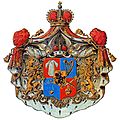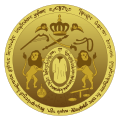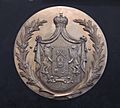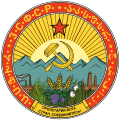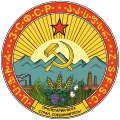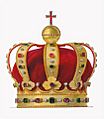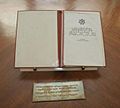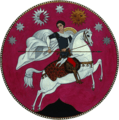Coat of arms of Georgia (country) facts for kids
Quick facts for kids Coat of arms of Georgia |
|
|---|---|
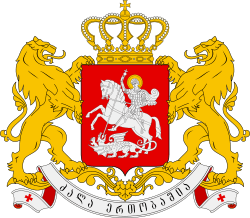 |
|
| Versions | |
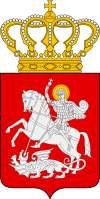
Lesser
|
|
| Armiger | Georgia |
| Adopted | 1 October 2004 (latest rendition) |
| Crest | Iverian (Georgian) crown Or |
| Blazon | On a purpure field is depicted a silver rider on a silver horse and with a silver spear ending with a golden cross, Saint George with a golden halo, striking a silver dragon. |
| Supporters | two lions rampant Or |
| Compartment | Stylized grape vine ornament Or |
| Motto | ძალა ერთობაშია Dzala Ertobashia "Strength is in Unity" |
The coat of arms of Georgia is a special national symbol of the country. It is partly based on the old designs used by the Georgian royal family from the Middle Ages. The main image on the coat of arms is Saint George, who is the traditional patron saint of Georgia.
Contents
What the Coat of Arms Shows
The coat of arms has a red (called gules in heraldry) background. On this background, you see Saint George riding a white (argent) horse. Saint George is shown defeating a crawling dragon with his spear. All parts of Saint George, his horse, and the dragon are silver.
Two golden (or) lions stand on either side, holding up the shield. These lions are shown standing on their back legs, which is called rampant. Above the shield is the royal crown of Georgia, also in gold.
Below the shield, there is a motto written in the Mkhedruli script of the Georgian alphabet. The motto says "Strength is in Unity" (Dzala Ertobashia).
Georgia's Past Coats of Arms
Georgia has had different coats of arms throughout its history.
1918-1921 and 1991-2004
This coat of arms was used by the Democratic Republic of Georgia when it existed from 1918 to 1921. Even though Saint George was a long-standing symbol for Georgia, people discussed other ideas for the coat of arms. One idea was to use Amiran, a hero who symbolized Georgia's fight for freedom from the Russian Empire. However, they decided to stick with Saint George.
This same coat of arms was brought back in 1991 after Georgia became independent again. It was used until 2004, when the current design was adopted.
1801-1917
Before 1917, Georgia was part of the Russian Empire. During this time, the Georgian coat of arms was included in the larger Coat of Arms of the Russian Empire. It was a smaller shield placed in the center of the Caucasus region's coat of arms.
This design showed Saint George the Victorious in blue armor with a cross on his chest. He wore a red cloak and rode a black (sable) horse. The horse was covered with a red cloth and was trampling a green (vert) dragon. Saint George's spear pierced the dragon's head.
Before 1801
Before 1801, the coats of arms mostly belonged to the Bagrationi royal family. They believed they were related to King David from the Bible. Their coats of arms sometimes included symbols like King David's lyra (a type of harp) and sling, or even the Holy Tunic.
Images for kids
-
An 1807 metalwork of the Georgian royal coat of arms
-
Coat of arms design used by the First Republic (1918-1921), as well as post-communist Georgia (1991-2004)
-
Coat of arms of the Democratic Republic of Georgia (1918-1921)
-
Coat of Arms of the Transcaucasian Socialist Federative Soviet Republic (1922-1924)
-
Coat of Arms of the Transcaucasian Socialist Federative Soviet Republic (1924-1930)
-
Coat of Arms of the Transcaucasian Socialist Federative Soviet Republic (1930-1936)
-
Coat of arms design used by the First Republic (1918–1921), as well as post-communist Georgia (1991–2004)
See also
 In Spanish: Escudo de Georgia para niños
In Spanish: Escudo de Georgia para niños


